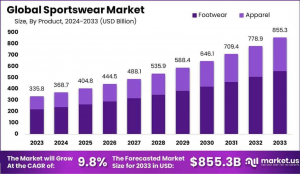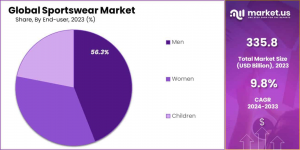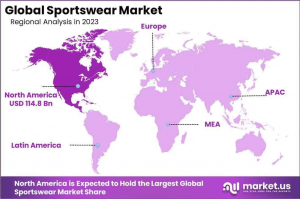Sportswear Market size is expected to be worth around USD 855.3 Billion by 2033, from USD 335.8 Billion in 2023, growing at a CAGR of 9.8%.
North America holds 34.2% of the Sportswear Market, valued at USD 114.8 billion, supported by strong fitness culture and a wide range of professional sports.”
NEW YORK, NY, UNITED STATES, January 22, 2025 /EINPresswire.com/ -- Market Overview— Tajammul Pangarkar
The Global Sportswear Market size is expected to be worth around USD 855.3 Billion by 2033, from USD 335.8 Billion in 2023, growing at a CAGR of 9.8% during the forecast period from 2024 to 2033. North America dominated a 34.2% market share in 2023 and held USD 114.8 Billion in revenue from the Sportswear Market.
The sportswear market refers to the sector dedicated to manufacturing and selling clothing, footwear, and accessories specifically designed for physical activities, including sports, fitness, and outdoor pursuits.
It encompasses a broad range of products, from performance-enhancing gear to athleisure fashion, catering to both athletes and fitness enthusiasts. The market has experienced significant growth due to increased health consciousness, sports participation, and the merging of style with functionality in everyday wear.
The sportswear industry has witnessed robust growth, driven by rising awareness of health and fitness and a global shift towards active lifestyles. Major opportunities exist in emerging markets, where disposable income levels are on the rise and the demand for premium athletic wear continues to grow. Governments globally have been investing in sports infrastructure and initiatives aimed at encouraging physical activity, further boosting demand.
Additionally, regulations around sustainability, material sourcing, and labor conditions are shaping industry practices, pushing brands toward more eco-friendly innovations and ethical production processes. These factors present long-term growth prospects while ensuring that the market remains adaptable to evolving consumer preferences and global trends.
For new entrants, understanding the dynamics of local and global sportswear markets is crucial for crafting competitive strategies. This report offers valuable insights into market segmentation, consumer behavior, and key trends, helping new players align their product offerings to target the right audience.
Existing players should use this report to identify untapped opportunities and strengthen their position in competitive regions. Expanding product lines, adopting sustainability practices, and investing in digital platforms are key strategies for growth. Moreover, existing players can leverage market intelligence to adjust their approach based on changing consumer demands and regulatory landscapes.
Curious About Market Trends? Request Your Complimentary Sample Report Today: https://market.us/report/sportswear-market/free-sample/
Key Takeaway
-The Global Sportswear Market size is expected to be worth around USD 855.3 Billion by 2033, from USD 335.8 Billion in 2023, growing at a CAGR of 9.8% during the forecast period from 2024 to 2033.
-In 2023, Footwear held a dominant market position in the by-product segment of the Sportswear Market, with a 65.2% share.
-In 2023, Men held a dominant market position in the end-user segment of the Sportswear Market, with a 56.3% share.
-In 2023, Offline held a dominant market position in the By Distribution Channel segment of the Sportswear Market, with a 33.1% share.
-North America dominated a 34.2% market share in 2023 and held USD 114.8 Billion in revenue from the Sportswear Market.
Use Cases
1.Performance Enhancement Apparel: Sportswear brands are increasingly focusing on creating apparel that enhances performance, such as moisture-wicking fabrics and compression wear. These clothes help athletes stay dry and comfortable during intense physical activity.
2. Sustainable Sportswear: With the growing trend toward sustainability, companies are producing sportswear made from eco-friendly materials like recycled polyester and organic cotton. This caters to environmentally conscious consumers.
3. Smart Sportswear: The integration of technology into sportswear has led to the development of “smart” clothing, such as shirts or socks with sensors that track heart rate, body temperature, and performance metrics during exercise.
4. Outdoor Sports Gear: Sportswear brands are expanding into the outdoor segment by creating specialized apparel for activities like hiking, cycling, and skiing. These products are designed for durability, weather resistance, and enhanced mobility in challenging environments.
5. Active Lifestyle Clothing: There is increasing demand for sportswear that blends functionality with style. Athleisure, a category of sportswear designed for both exercise and casual wear, has seen rapid growth. Consumers now look for clothes that can transition seamlessly between workouts and everyday activities.
Driving Factors
Increased Health Consciousness: As more people focus on health and fitness, the demand for sportswear has surged. Consumers are becoming more aware of the importance of physical activity, leading to greater sales of activewear like running shoes, leggings, and athletic shirts. This trend is driven by rising interest in healthy lifestyles and fitness activities.
Fashion Trends and Athleisure: The crossover between fashion and function has boosted sportswear popularity. Athleisure—the trend of wearing workout clothes as casual or even business attire—has become mainstream. This is particularly attractive for busy consumers who prioritize comfort without sacrificing style.
Growth of E-commerce: Online shopping has made it easier for consumers to buy sportswear from a wide range of brands, often at better prices or with more convenience. E-commerce platforms allow for quick product discovery, and direct-to-consumer models enable brands to engage more closely with their audience, increasing sales.
Sponsorship and Influencer Endorsements: Many sports brands collaborate with athletes, celebrities, and influencers to promote their products. These endorsements not only drive sales but also increase brand visibility and loyalty. Social media platforms like Instagram and TikTok amplify these marketing efforts, allowing brands to tap into larger and more diverse consumer bases.
Innovation in Materials and Technology: Advancements in fabric technology, such as moisture-wicking, breathable, and antibacterial materials, have made sportswear more comfortable and functional. These innovations make it easier for consumers to choose sportswear that fits their performance needs, whether they are for running, yoga, or other sports activities.
Report Segmentation
In 2023, the Sportswear Market was largely driven by the footwear segment, which held a dominant 65.2% share, thanks to increased consumer interest in athletic and leisure activities, along with improvements in footwear technology.
Men’s sportswear led the market by end-user, accounting for 56.3% of the share, driven by higher participation in sports and physical activities. In terms of distribution, offline channels remained the most popular, holding a 33.1% share, with customers continuing to prefer in-store shopping for its ability to assess product fit, comfort, and quality, despite the rise of online shopping.
By Product
~Footwear
~Apparel
By End-user
~Men
~Women
~Children
By Distribution Channel
~Online
~Offline
~– Sporting Goods Retailers
~– Supermarkets & Hypermarkets
~– Exclusive Brand Outlets
~– Others
Ready to Act on Market Opportunities? Buy Your Report Now and Get upto 30% off: https://market.us/purchase-report/?report_id=41081
Regional Analysis
The sportswear market shows a diverse landscape across regions, shaped by different consumer preferences, climates, and economic conditions. In North America, the market leads with a significant 34.2% share, valued at USD 114.8 billion. This dominance is driven by a strong fitness culture and a wide range of both professional and amateur sports activities.
Growth Opportunities
Rising Health and Fitness Trends: Increasing health awareness and fitness trends are pushing demand for sportswear. People are investing in activewear for exercise, yoga, and outdoor activities. Brands can target this expanding consumer base by offering a range of fitness-oriented clothing and accessories.
Athleisure Fashion: Athleisure, clothing designed for both athletic and everyday wear, is becoming a major fashion trend. Companies can tap into this by blending stylish designs with comfort, making their sportswear suitable for both workouts and casual outings, appealing to a wider audience.
Sustainability Focus: With growing consumer interest in eco-friendly products, brands can create sportswear using sustainable materials like organic cotton, recycled polyester, and eco-friendly dyes. This will attract environmentally-conscious customers and enhance brand loyalty.
E-commerce Growth: The increasing preference for online shopping is creating significant opportunities for sportswear brands. By expanding digital presence and offering seamless online shopping experiences, companies can reach a global audience and boost sales.
Technological Advancements in Fabrics: The use of advanced fabric technology, such as moisture-wicking, temperature-regulating, and antimicrobial fabrics, provides opportunities for innovation. Brands can introduce products with these features to improve comfort and performance, appealing to athletes and fitness enthusiasts.
Key Players
~Nike Inc.
~Adidas
~Puma SE
~Lululemon Athletica Inc.
~Under Armour Inc.
~Umbro
~Columbia Sportswear Company
~Anta Sports
~Li Ning Group
~Other Key Players
Not Sure? Request a Sample Report and See How Our Insights Can Drive Your Business: https://market.us/report/sportswear-market/free-sample/
Trending Factors
1. Growing Popularity of Fitness & Health Consciousness
There has been a rising trend in consumers prioritizing fitness and a healthy lifestyle. As people focus more on exercise and wellness, the demand for high-performance sportswear like activewear, running shoes, and yoga clothes has increased.
2. Rise of Athleisure
Athleisure, a mix of athletic wear and casual clothing, has become fashionable. People are wearing sportswear not only for exercise but as part of their daily casual outfits. This has expanded the market beyond just athletes and fitness enthusiasts to the general public.
3. Increasing Online Shopping
E-commerce has become a dominant way to shop for sportswear. With convenience and a wide range of options, more consumers are buying sports apparel online. Retailers are offering personalized shopping experiences, making it easier for customers to purchase what they need.
4. Sustainable and Eco-friendly Products
Consumers are increasingly aware of environmental issues, leading them to prefer sportswear made from sustainable, eco-friendly materials. Brands are adopting practices such as using recycled fabrics and reducing carbon footprints to cater to this growing demand.
5. Technological Innovations in Fabrics
Advancements in fabric technology have improved the performance of sportswear. Features such as moisture-wicking, breathable materials, and enhanced flexibility make these products more functional. Smart textiles, including clothes with embedded sensors for tracking health metrics, are also gaining traction.
Restraining Factors
1. High Competition and Price Sensitivity The sportswear market faces significant competition from both established brands and new entrants. Major players like Nike, Adidas, and Puma dominate the space, leaving smaller brands with limited market share. This intense competition often leads to price wars, which can lower profit margins. Additionally, consumers in many markets are highly price-sensitive and may switch brands based on discounts, promotions, or perceived value, making it challenging for companies to maintain premium pricing strategies.
2. Economic Downturns and Consumer Spending Economic downturns or periods of recession can severely impact consumer spending on non-essential goods, including sportswear. During tough financial times, consumers may prioritize necessities and cut back on spending for leisure activities, fitness, or sports. This reduction in disposable income directly affects the demand for sports apparel, particularly high-end or specialized products that come with higher price tags.
3. Sustainability Concerns and Ethical Manufacturing The growing focus on sustainability is a double-edged sword for the sportswear market. While many brands are shifting towards eco-friendly products, the process of manufacturing and sourcing materials sustainably can increase production costs. Brands that don’t adopt environmentally friendly practices may face backlash from consumers who are becoming more eco-conscious. In addition, issues related to unethical labor practices in supply chains can damage brand reputation and result in consumer boycotts.
Conclusion
The Global Sportswear Market is poised for significant growth, projected to reach USD 855.3 billion by 2033, driven by heightened health consciousness, fashion trends, and technological advancements in sportswear fabrics. As consumers increasingly demand both functional and stylish sportswear suitable for both fitness activities and casual wear, companies have lucrative opportunities to innovate and expand, especially in sustainable products and e-commerce. However, they must navigate challenges such as intense competition, economic fluctuations, and the complexities of ethical manufacturing to sustain growth and maintain consumer trust. The strategic focus on understanding consumer preferences and leveraging technological innovations will be key to capitalizing on these emerging market dynamics.
Lawrence John
Prudour
+91 91308 55334
Lawrence@prudour.com
Legal Disclaimer:
EIN Presswire provides this news content "as is" without warranty of any kind. We do not accept any responsibility or liability for the accuracy, content, images, videos, licenses, completeness, legality, or reliability of the information contained in this article. If you have any complaints or copyright issues related to this article, kindly contact the author above.




